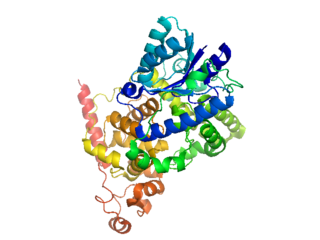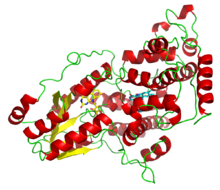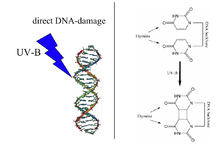
Arabidopsis thaliana, the thale cress, mouse-ear cress or arabidopsis, is a small plant from the mustard family (Brassicaceae), native to Eurasia and Africa. Commonly found along the shoulders of roads and in disturbed land, it is generally considered a weed.
Cyclobutane is a cycloalkane and organic compound with the formula (CH2)4. Cyclobutane is a colourless gas and is commercially available as a liquefied gas. Derivatives of cyclobutane are called cyclobutanes. Cyclobutane itself is of no commercial or biological significance, but more complex derivatives are important in biology and biotechnology.
In developmental biology, photomorphogenesis is light-mediated development, where plant growth patterns respond to the light spectrum. This is a completely separate process from photosynthesis where light is used as a source of energy. Phytochromes, cryptochromes, and phototropins are photochromic sensory receptors that restrict the photomorphogenic effect of light to the UV-A, UV-B, blue, and red portions of the electromagnetic spectrum.

Cryptochromes are a class of flavoproteins found in plants and animals that are sensitive to blue light. They are involved in the circadian rhythms and the sensing of magnetic fields in a number of species. The name cryptochrome was proposed as a portmanteau combining the chromatic nature of the photoreceptor, and the cryptogamic organisms on which many blue-light studies were carried out.

Aziz Sancar is a Turkish molecular biologist specializing in DNA repair, cell cycle checkpoints, and circadian clock. In 2015, he was awarded the Nobel Prize in Chemistry along with Tomas Lindahl and Paul L. Modrich for their mechanistic studies of DNA repair. He has made contributions on photolyase and nucleotide excision repair in bacteria that have changed his field.

Pyrimidine dimers represent molecular lesions originating from thymine or cytosine bases within DNA, resulting from photochemical reactions. These lesions, commonly linked to direct DNA damage, are induced by ultraviolet light (UV), particularly UVC, result in the formation of covalent bonds between adjacent nitrogenous bases along the nucleotide chain near their carbon–carbon double bonds, the photo-coupled dimers are fluorescent. Such dimerization, which can also occur in double-stranded RNA (dsRNA) involving uracil or cytosine, leads to the creation of cyclobutane pyrimidine dimers (CPDs) and 6–4 photoproducts. These pre-mutagenic lesions modify the DNA helix structure, resulting in abnormal non-canonical base pairing and, consequently, adjacent thymines or cytosines in DNA will form a cyclobutane ring when joined together and cause a distortion in the DNA. This distortion prevents DNA replication and transcription mechanisms beyond the dimerization site.
Postreplication repair is the repair of damage to the DNA that takes place after replication.

DNA damage-binding protein 2 is a protein that in humans is encoded by the DDB2 gene.

Cystathionine beta-lyase, also commonly referred to as CBL or β-cystathionase, is an enzyme that primarily catalyzes the following α,β-elimination reaction
Spore photoproduct lyase is a radical SAM enzyme that repairs DNA cross linking of thymine bases caused by UV-radiation. There are several types of thymine cross linking, but SPL specifically targets 5-thyminyl-5,6-dihydrothymine, which is also called spore photoproduct (SP). Spore photoproduct is the predominant type of thymine crosslinking in germinating endospores, which is why SPL is unique to organisms that produce endospores, such as Bacillus subtilis. Other types of thymine crosslinking, such as cyclobutane pyrimidine dimers (CPD) and pyrimidine (6-4) pyrimidone photoproducts (6-4PPs), are less commonly formed in endospores. These differences in DNA crosslinking are a function of differing DNA structure. Spore genomic DNA features many DNA binding proteins called small acid soluble proteins, which changes the DNA from the traditional B-form conformation to an A-form conformation. This difference in conformation is believed to be the reason why dormant spores predominantly accumulate SP in response to UV-radiation, rather than other forms of cross linking. Spores cannot repair cross-linking while dormant, instead the SPs are repaired during germination to allow the vegetative cell to function normally. When not repaired, spore photoproduct and other types of crosslinking can cause mutations by blocking transcription and replication past the point of the crosslinking. The repair mechanism utilizing spore photoproduct lyase is one of the reasons for the resilience of certain bacterial spores.
The term proofreading is used in genetics to refer to the error-correcting processes, first proposed by John Hopfield and Jacques Ninio, involved in DNA replication, immune system specificity, and enzyme-substrate recognition among many other processes that require enhanced specificity. The proofreading mechanisms of Hopfield and Ninio are non-equilibrium active processes that consume ATP to enhance specificity of various biochemical reactions.
Somatic recombination, as opposed to the genetic recombination that occurs in meiosis, is an alteration of the DNA of a somatic cell that is inherited by its daughter cells. The term is usually reserved for large-scale alterations of DNA such as chromosomal translocations and deletions and not applied to point mutations. Somatic recombination occurs physiologically in the assembly of the B cell receptor and T-cell receptor genes, as well as in the class switching of immunoglobulins. Somatic recombination is also important in the process of carcinogenesis.
DNA photolyase, N-terminal is an evolutionary conserved protein domain. This domain binds a light harvesting chromophore that enhanced the spectrum of photolyase or cryptochrome light absorption, i.e. an antenna. It adopts the rossmann fold.
Radical SAMenzymes is a superfamily of enzymes that use a [4Fe-4S]+ cluster to reductively cleave S-adenosyl-L-methionine (SAM) to generate a radical, usually a 5′-deoxyadenosyl radical (5'-dAdo), as a critical intermediate. These enzymes utilize this radical intermediate to perform diverse transformations, often to functionalize unactivated C-H bonds. Radical SAM enzymes are involved in cofactor biosynthesis, enzyme activation, peptide modification, post-transcriptional and post-translational modifications, metalloprotein cluster formation, tRNA modification, lipid metabolism, biosynthesis of antibiotics and natural products etc. The vast majority of known radical SAM enzymes belong to the radical SAM superfamily, and have a cysteine-rich motif that matches or resembles CxxxCxxC. Radical SAM enzymes comprise the largest superfamily of metal-containing enzymes.
(6-4)DNA photolyase is an enzyme with systematic name (6-4) photoproduct pyrimidine-lyase. This enzyme catalyses the following chemical reaction
Steve A. Kay is a British-born chronobiologist who mainly works in the United States. Dr. Kay has pioneered methods to monitor daily gene expression in real time and characterized circadian gene expression in plants, flies and mammals. In 2014, Steve Kay celebrated 25 years of successful chronobiology research at the Kaylab 25 Symposium, joined by over one hundred researchers with whom he had collaborated with or mentored. Dr. Kay, a member of the National Academy of Sciences, U.S.A., briefly served as president of The Scripps Research Institute. and is currently a professor at the University of Southern California. He also served on the Life Sciences jury for the Infosys Prize in 2011.

Drosophila circadian rhythm is a daily 24-hour cycle of rest and activity in the fruit flies of the genus Drosophila. The biological process was discovered and is best understood in the species Drosophila melanogaster. Other than normal sleep-wake activity, D. melanogaster has two unique daily behaviours, namely regular vibration during the process of hatching from the pupa, and during mating. Locomotor activity is maximum at dawn and dusk, while eclosion is at dawn.
Mutational signatures are characteristic combinations of mutation types arising from specific mutagenesis processes such as DNA replication infidelity, exogenous and endogenous genotoxin exposures, defective DNA repair pathways, and DNA enzymatic editing.
Magnetotropism is the movement or plant growth in response to the stimulus provided by the magnetic field in plants around the world. As a natural environmental factor in the Earth, variations of magnetic field level causes many biological effects, including germination rate, flowering time, photosynthesis, biomass accumulation, activation of cryptochrome, and shoot growth.
The chlorophyll a/b-binding protein gene, otherwise known as the CAB gene, is one of the most thoroughly characterized clock-regulated genes in plants. There are a variety of CAB proteins that are derived from this gene family. Studies on Arabidopsis plants have shed light on the mechanisms of biological clocks under the regulation of CAB genes. Dr. Steve Kay discovered that CAB was regulated by a circadian clock, which switched the gene on in the morning and off in the late afternoon. The genes code for proteins that associate with chlorophyll and xanthophylls. This association aids the absorption of sunlight, which transfers energy to photosystem II to drive photosynthetic electron transport.








